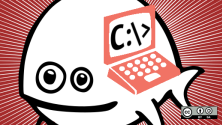In the early 1990s, I was a DOS "power user." I used DOS for everything and even wrote my own tools to extend the DOS command line. Sure, we had Microsoft Windows, but if you remember what computing looked like at the time, Windows 3.1 was not that great. I preferred working in DOS.
You might understand that I was a little confused and upset in 1994 when Microsoft announced (via interviews in tech magazines) that the next version of Windows would do away with MS-DOS. I thought, "If Windows 3.2 or 4.0 looks anything like Windows 3.1, I want nothing to do with that." I looked around for options and decided that if DOS was going to continue, someone would have to create a DOS that everyone could use when MS-DOS went away.
So it was on June 29, 1994, that I wrote a message to a Usenet discussion group, announcing a new "free DOS" project:
A few months ago, I posted articles relating to starting a public domain version of DOS. The general support for this at the time was strong, and many people agreed with the statement, "start writing!"
So, I have...
Announcing the first effort to produce a PD-DOS. I have written up a "manifest" describing the goals of such a project and an outline of the work, as well as a "task list" that shows exactly what needs to be written. I'll post those here, and let discussion follow.
Today, it's 23 years later, and FreeDOS is still going strong!
We continue to make new releases with new functionality and features. Our FreeDOS 1.2 distribution, released on December 25, 2016, is a testament to how many people enjoy using and working on FreeDOS. As I look back over our history, there's a short list of cool facts about FreeDOS you should know:
Software development right out of the box
With the original DOS, it was difficult to do any coding. DOS provided a simple BASIC interpreter, and some people could do neat things with DEBUG, but you couldn’t really do much programming in DOS. With FreeDOS, there are a bunch of different tools to do software development: compilers, assemblers, debuggers, interpreters, and scripting. After you install FreeDOS, you can immediately start writing code in C, Assembly, Pascal, Perl, and several other languages.
Browse the web
DOS is an old system and the original didn't support networking out of the box. Typically, you had to install device drivers for your hardware to connect to a network, which was usually a simple network like IPX. Few systems supported TCP/IP.
With FreeDOS, not only do we include a TCP/IP networking stack, we include tools and programs that let you browse the web. Use Dillo for a graphical web browser experience, or Lynx to view the web as formatted plain text. If you just want to grab the HTML code and manipulate it yourself, use Wget or Curl.
Play great DOS games
We know that many people install FreeDOS today to play the classic DOS games, run legacy business applications, or do embedded development. A lot of those people use FreeDOS just to play games, and that’s cool with us. Just because a game is old doesn’t mean it's boring. DOS had a lot of great games! Install your favorite classic game and have fun.
Because so many people use FreeDOS to play games, we now include a variety of DOS games. The FreeDOS 1.2 distribution includes first-person shooters like FreeDOOM, arcade shooters like Kiloblaster, flight simulators like Vertigo, and others. We aimed to include something for everyone.
FreeDOS has now been around longer than MS-DOS
Microsoft released MS-DOS 1.0 in August 1981. And thirteen years later, Microsoft effectively deprecated MS-DOS with the release of Windows 95 in August 1995, although MS-DOS was still around in some form until September 2000. In total, MS-DOS was a thing for nineteen years.
We announced FreeDOS in June 1994 and made our first Alpha release in September that same year. So FreeDOS has been around for 23 years, edging out Microsoft’s MS-DOS by a few years. Truly, we've been working on FreeDOS for longer than MS-DOS was a thing. FreeDOS has staying power.
Another important way that FreeDOS is different from other versions of DOS is that it is still being developed. We have an active developer community and are always looking for new people to help out. Join the community and help build the next version of FreeDOS.







2 Comments